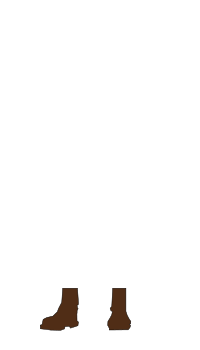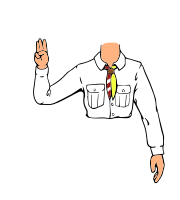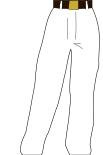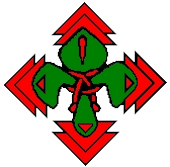Scouting Ireland
| Scouting Ireland | |||
|---|---|---|---|
|
membership badge | |||
| Headquarters | Larch Hill | ||
| Country | Republic of Ireland, Northern Ireland | ||
| Founded | 1 January 2004 | ||
| Founder | Richard P. Fortune (1908) | ||
| Membership |
50,000 (As of 3 June 2016)[1] | ||
| Chief Scout | Christy McCann | ||
| Affiliation | World Organization of the Scout Movement | ||
|
| |||
|
Website http://www.scouts.ie | |||

   | |||

Scouting Ireland (Irish: Gasóga na hÉireann) is the sole World Organization of the Scout Movement-recognised Scouting association in the Republic of Ireland; in Northern Ireland it operates alongside The Scout Association of the UK. Scouting Ireland is a voluntary, non-formal educational movement for young people. It is independent, non-political, open to all without distinction of origin, race, creed, sexual orientation, spiritual belief or gender, in accordance with the purpose, principles and method conceived by Lord Baden-Powell and as stated by WOSM.[2]
The aim of Scouting Ireland is to encourage the Social, Physical, Intellectual, Character Emotional, and Spiritual development (known as the SPICES) of young people "so that they may achieve their full potential and as responsible citizens, to improve society".[3] Of the 750,000 people between the ages of 6 and 18 in Ireland, approximately 6% are involved in Scouting Ireland. The organisation was founded on 21 June 2003, after a merger between Scouting Ireland C.S.I. and Scouting Ireland S.A.I..[2][4] Its headquarters are at Larch Hill, County Dublin.[2]
The association is headed by the Chief Scout, currently Christy McCann, supported by the National Management Committee and Chief Executive Officer, John Lawlor.
History

The Scouting Ireland organisation has its basis in two separate Irish Scouting organisations — the Scout Association of Ireland (SAI), formerly known as the Boy Scouts of Ireland, and the Catholic Boy Scouts of Ireland (CBSI). The former traces its roots to 1908, and the latter was founded in 1927 – both trace their legacy to Lord Baden-Powell's Scout Movement.
By 1908, the influence of Baden-Powell's Scout Movement had spread from Great Britain to Ireland. The first recorded meeting of Scouts in Ireland took place at the home of Richard P. Fortune, a Royal Naval Volunteer Reservist, at 3 Dame Street, Dublin on 15 February 1908 where four boys were enrolled in the Wolf Patrol of the 1st Dublin Troop. The earliest known Scouting event in Ireland took place in the Phoenix Park in 1908 with members of the Dublin City Boy Scouts (later Scouting Ireland S.A.I.) taking part.
Because of the impacts to available adult leadership, the coming of the Great War in 1914 could have affected the viability of Scouting in Ireland. However, patrol leader members took over much of the leadership activities when adult leaders volunteered for active military duty. Scouts contributed to the war effort in several ways; notably the Sea Scouts, who supported regular coast guardsmen.
In Dublin in the 1920s, two Roman Catholic priests, Fathers Tom and Ernest Farrell, followed the progress of Scouting. They noted that in other countries, the Catholic Church had taken up the idea of Scouting as a means of imprinting a Catholic ethos on young people. After some study and experimentation, they made a proposal to the Catholic Hierarchy of Ireland and were granted a constitution and Episcopal patronage in November 1926. Thus, the Catholic Boy Scouts of Ireland (CBSI) (Gasóga Catoilici na hÉireann) was created. CBSI would later become the largest Scout association on the island.
When war came again in 1939, Scouts carried on under the direction of their patrol leaders, and undertook service tasks. Including acting as messengers, fire watchers, stretcher bearers, salvage collectors, etc.

In 1965, CBSI joined with SAI to form the Federation of Irish Scout Associations, FISA. Through FISA, Irish Scouts were able to play a full part in international Scouting. Prior to this, because the World Organisation of the Scout Movement (WOSM) traditionally recognises only one Scouting body in each country, only SAI had been recognised by WOSM (since 1949).[5] Similarly, the Northern Irish Scout Council (NISC) had observer status in the Federation, as CBSI's membership extended across the 32 counties on the island of Ireland and WOSM usually only recognises associations that observe political boundaries.
Although aligned through FISA, these two separate Scouting organisations (SAI and the much larger CBSI) operated as separate entities through the latter half of the 20th century. Then, on 1 January 2004, the two organisations were merged to form 'Scouting Ireland'. This followed votes in May 2003, when both associations agreed to join together to form a new single association. This in turn had followed from decisions in 1998 to set this process in motion.[4] [6]
Scouting Ireland has 50,000 members across the island of Ireland (as of June 2016),[1] including Northern Ireland, where it works in partnership with the Scout Association in Northern Ireland (SANI), which is part of the United Kingdom Scout Association The Scout Association.
Local volunteers working in Scout Groups and Scout Counties and also various national teams are supported by a centralised full-time (professional) staff, who support the day-to-day running of the association.
Sections
Scouting Ireland offers a programme for youth members ages between 6 and 25 years.[7]
- Beaver Scouts – Ages 6, 7 and 8
- Cub Scouts – Ages 9, 10 and 11
- Scouts – Ages 12, 13, 14 and 15
- Venture Scouts – Ages 15, 16 and 17
- Rover Scouts – Ages 18 to 25
- Sea Scouts – Sea Scouting is a model for implementing the Scout Method with an emphasis on maritime tradition, nautical skills and water based activities. Sea Scouting operates throughout the sections consistent with the above age ranges.
The National Management Committee can decide on variations to the Section names for use with a specific Symbolic Framework adopted by a Scout Group Council.
Management and representation
Scout Group
The basic unit of Scouting in Ireland is the Scout Group. Each Group is based around a single meeting point, but may have a number of sections, meeting at different times, and may have more than one Scout Troop or Cub Scout Pack, for example. The Group is coordinated by the Group Council, headed up by the Group Leader. Membership includes various Group appointments (like Secretary and Treasurer), adult representatives of all sections and youth representatives of the Scouts, Venture Scout and Rover Scout sections.
Scout County
Scout Groups are members of their local Scout County. Some are based on geographical counties, others, depending on density, are based in parts of cities or across county boundaries. The Scout County supports the training of Scouters, the youth programme and the development of Groups within the County. The Scout County Board, which meets at least once a year, consists of representatives of each Scout Group, elected youth representatives of the Scouts, Venture Scout and Rover Scout sections and holders of various County appointments (County Commissioner, County Secretary, County Treasurer) as well as County Programme and Training Co-ordinators.
The Scout County Management Committee consists of the Group Leaders, holders of the various County appointments.
Provinces
For organisational purposes, Ireland is divided into six Scout Provinces; namely the Northern, Southern, North Eastern, South Eastern, Western and Dublin provinces. The Provincial Commissioner appoints a Training Co-Ordinator as well as Youth Programme and International representatives. The Provincial Management/Support Committee consists of County Commissioners, Provincial Officers, Co-ordinators and representatives.
Each Province has a Provincial Support Officer and a Group Facilitating Officer who administrate the development of Training and Youth Programme.
National Council
The primary decision making body of Scouting Ireland is National Council, which meets at least once a year. Membership consists of members of the National Management Committee, youth and adult representatives of each Scout Group in the country, and the National Youth Representatives as well as the holders of some County appointments. National Council is the vehicle for amendments to the movement's Rules and its Constitution. It also elects the members of the National Management Committee.
National Management Committee
The first Chief Scout elected was Martin Burbridge, the former National Treasurer of Scouting Ireland (CSI). He was re-elected at National Council in 2007 for a second term which was due to end in 2010. For personal reasons Burbridge announced his resignation in August 2008, and the NMC elected Michael John Shinnick, the then Chief Commissioner for Adult Resources, as SI's second Chief Scout in September 2008.[8][9] He was elected by National Council in March 2009, and again in 2012, for a term to end in 2015.[10][11] Christy McCann was elected as SI's third Chief Scout in September 2015.[12][13][14]
Other National Officers include Jimmy Cunningham (National Secretary), Annette Byrne (National Treasurer), Dave Shalloo (Chief Commissioner for Youth Programme) & Therese Bermingham (Chief Commissioner for Adult Resources).[13] Pat O'Sulleabhain is the Chairperson of the National Spiritual and Religious Advisory Panel.[13]
The remainder of the NMC is made up of the six Provincial Commissioners, the International Commissioner, the Communications Commissioner, and six ordinary members.[13] Scouting Ireland's Chief Executive Officer is John Lawlor, who is based in National Office in Larch Hill.[15] The CEO is expected to attend and contribute to NMC meetings.[16]
Youth participation
A National Youth Forum is held each year with representatives from the Scout, Venture Scout and Rover Scout sections. Representatives debate motions relating to the running of the association and their own sections. Successful motions are carried forward to the relevant national bodies, even National Council. Each forum elects 9 representatives who then represent the interests of youth members on various committees throughout their term of office (one year). 3 ordinary members of the National Management Committee must also be under the age of 26 on the day of election.
ONE Programme
The ONE Scout programme has been designed using a number of key underlining principles.
• The use of the Scout Method • One programme for all age ranges • Youth Participation within the planning process • Individual personal journeys/experiences
One Programme for all
The principle of 'ONE Programme for all' means that each age range section delivers the programme in a similar way. Small groups are present in all Sections. Documentation is designed to appeal to the age range of the Section but presents the same concepts to young people in appropriate visual presentations and language. The badge scheme is also similar and the badge designs only signify different age ranges via different coloured designs.
Programme creation
Young people are fully involved in the creation and management of their Scouting experience. This is done via the team and Section Council gatherings. They suggest, design and implement their own adventures and experiences assisted and facilitated by Adult Scouters. This collective experience is the programme of the group.
Personal Journey
Every Scout is responsible for their own Personal Journey/experience of Scouting and plays a hand in designing and planning that journey. The Personal Journey ideal draws a young person to explore the SPICES and enable them to learn, acquire knowledge and develop while participating in the Scout programme. The programme, that young people have designed with the help and assistance of Scouters follows a simple process PLAN, DO, REVIEW. Programmes are planned, activities are executed and the whole process is reviewed. The review process is an important stage as it allows young people to learn by doing, reflect on what has been learnt and carry this knowledge through to the next programme cycle. The review and reflection process is an important part of the personal journey of young people. It allows them to position themselves on their chosen path and provides them with pathways to future discoveries and experiences.
Badges
There are four types of badges available to young people.
- Progress Award Badges
- Adventure Skills Badges[17]
- Special Interest Badges[17]
- Boatman Badges Scouter
Personal Progress badges
Personal Progress Badges are awarded to young people in recognition of how they have developed and travelled along their personal Scouting journey. The badges are roughly linked to a 'Scouting years' programme. It is not based on individual tests but rather on a concept of bringing young people 'one step forward'. For some young people this will be easy for others more challenging. It will also be related to maturity of young people as they grow and develop. Scouters therefore need to be fully aware of 'where their Scouts are at' so they can have a fuller understanding of how far a young person has travelled in a particular Stage.
Adventure Skills badges
Adventure skills badges set prescribed detailed requirements to young people to achieve a set standard in a particular adventure skill. The requirements are progressive and ultimately reflect and pave the way to outside recognition by a governing body of a chosen skill. There are currently nine adventure skills badges.[17]
Special Interest badges
Special interest badges are open ended badges that reflect the interest of the young person undertaking them. Any subject is possible and the requirements are designed by the young person in consultation and agreement with their Scouters.[18] There are five badge designs, badges are presented under a number of heading into which the special interest subject will fall. Heading include -Skill, Physical, Adventure, Community, Environment.[18][19] Badge requirements will differ depending on the individual, the main requirement being 'doing one's best', recognising personal effort, rather than achieving a prescribed standard.[17][18] Badge requirements are broad enough to allow youth members to set agree their own criteria with their Scouter.[17]
Chief Scout Award
The Chief Scout Award is the superlative youth programme award in each of the Programme Sections. It is designed to tie-in with the Gaisce Award, and the Chief Scout Award for Scouts, Ventures Scouts, and Rover Scouts are awarded jointly with the Bronze, Silver and Gold awards respectively.[20] Requirements for the award are a number of Adventure Skills, Special Interest Badges, an Expedition, and camp with an inter-cultural aspect.[20][21]
Role of Scouters
The role of the Scouters is one of assisting, supporting, facilitating, motivating, being a role model rather than directive. Younger age ranges will require more facilitation and direction but this should be reversed in older age ranges to one of 'mentor or coach'. The Scouters need to be aware of the young people in their Section,and understand 'where they are' in relation to their development as young people. Scouters will assist in reviewing activities and help young people to reflect on their experiences and personal journey through Scouting.
Campsites
Campsites and Scout centres in Scouting Ireland, may be owned and operated Nationally, or by a Scout County, or Scout Group, or run by a group of volunteers on behalf of SI. Larch Hill in Tibradden, Co. Dublin, and Lough Dan near Roundwood, Co. Wicklow, are the national campsites, having been inherited from Scouting Ireland (CSI) and Scouting Ireland S.A.I. respectively. Other nationally owned campsites include Mount Melleray Scout Centre in the Knockmealdown Mountains near Cappoquin, Co. Waterford and Castle Saunderson International Scouting Centre, a new campsite in Co. Cavan while the National Water Activity Centre (NWAC) is located in Killaloe, Co. Clare.[22] Locally run campsites are located in Kilcully, Co. Cork, Collon, Co. Louth, Srahan Scout Centre, Co. Laois, Dundrum International Scout Campsite, Dundrum, Co. Tipperary, and Glendale Lodge, Glencree, Enniskerry, Co. Wicklow.[23][24][25][26]
International Scouting
Claire McAroe is the International Commissioner for Scouting Ireland.[13]
A number of Irish people have held office at international level, including as Chairman of the European Scout Committee and as Vice Chairman of the World Scout Committee. Howard E. Kilroy served as Chairman of the World Scout Foundation's Investment Committee.[27] In 2001 John Geoghegan was appointed director of the World Scout Foundation[28]
Five Irish Scouts have been awarded the Bronze Wolf Award by the World Scout Committee, Edward J. Montgomery (1977), Desmond Fay (1984), Jeremiah Kelly (1985), Howard Kilroy (2010) and Therese Bermingham (2015).
Scouting Ireland hosted Jamboree 2008, its first international Jamboree from 2–10 August 2008.[29] It was held in Punchestown Racecourse, County Kildare with the aim of celebrating one hundred years of Scouting in Ireland.[29] Around 12,500 Irish and overseas Scouts attended the event.[29]
In 2014, Scouting Ireland won the bid to host the 16th World Scout Moot an international Jamboree style event for Rover Scouts, which is due to take place in the summer of 2021.
In January 2016, Scouting Ireland signed a Memorandum of Understanding with the Lesotho Scouts Association.[30] The countries will participate in a partnership called Lumela-Fáilte, based on intercultural sharing. The partnership has been in progress since 2010, with Scouting Ireland supporting two Basotho Rover Scouts to attend the 2015 World Scout Jamboree.
Star Scout Show
The "Star Scout Show" is where members of Scouting Ireland perform acts of different kinds on stage. It usually takes place in Saint Patrick's College, Dublin. There is a song written especially for the show by Paul Redmond called "We Carry the Light". The show, performing to capacity audiences over three days, features a wide range of acts with music, dancing, drama and comedy, performed by Scouting Ireland Members of all ages and from several locations around Ireland, together with a strong representation from Dublin.[31]
See also
- Castle Saunderson
- Lough Dan
- Scouting in Northern Ireland
- Irish Scout Jamborees
- Gaisce – The President's Award
References
- 1 2 "Scouting Ireland reaches a membership of 50000". Scouting Ireland. 3 June 2016. Retrieved 7 June 2016.
- 1 2 3 "Scouts Link across the Border". The News Letter. 1 January 2004. Retrieved 6 March 2015 – via Questia. (subscription required (help)).
- ↑ "Scouting Ireland Constitution" (PDF). 2014. section 3. Retrieved 6 March 2015.
- 1 2 "The creation of Scouting Ireland" (PDF). World Organization of the Scout Movement. 2005. Archived from the original (PDF) on 30 June 2007. Retrieved 13 September 2006.
- ↑ "Some statistics". World Organization of the Scout Movement. Archived from the original on 12 October 2007.
- ↑ Patsy McGarry (May 12, 2003). "Wide welcome as scouts join forces". The Irish Times. Retrieved March 19, 2015 – via HighBeam Research. (subscription required (help)).
- ↑ "Scouting Ireland - InSIde Out" (pdf). Scouting Ireland. April 2013. p. 8. Retrieved 10 March 2015.
- ↑ Martin Burbridge (12 August 2008). "Letter from Chief Scout to the NMC on his impending Resignation". Archived from the original on 14 February 2009. Retrieved 6 March 2015.
- ↑ "New Chief Scout Elected". Scouting Ireland. Archived from the original on 14 February 2009. Retrieved 3 March 2015.
- ↑ "First Minister meets new Chief Scout". Archived from the original on 16 July 2009. Retrieved 3 March 2015.
- ↑ "PRESS RELEASE - SCOUTING IRELAND ELECTS CHIEF SCOUT FOR SECOND TERM.". Scouting Ireland. 3 April 2012. Retrieved 3 March 2015.
- ↑ Scouting Ireland official [ScoutingIreland] (12 September 2015). "Chief Scout Christy McCann delivering his first address as Scouting Ireland's new Chief Scout! #ScoutsIE" (Tweet). Retrieved 12 September 2015 – via Twitter.
- 1 2 3 4 5 "National Management Committee". Scouting Ireland. Retrieved 14 September 2016.
- ↑ Scouting Ireland [ScoutingIreland] (18 April 2015). "The NMC will appoint a chairperson for the National Team of Policy Implementation until an emergency national Council is organised #NC15" (Tweet). Retrieved 20 April 2015 – via Twitter.
- ↑ "Scouting Ireland appoint new CEO \date=1 March 2012". Retrieved 10 March 2015.
- ↑ "Scouting Ireland Constitution" (PDF). 2014. section 45. Retrieved 10 March 2015.
- 1 2 3 4 5 "What We Do In Scouting". Scouting Ireland. Retrieved 24 April 2015.
- 1 2 3 "Venture Special Interest Badges" (pdf). Scouting Ireland. Retrieved 23 April 2015.
- ↑ "Tullamore to host National Scouting Council". Offaly Express. 16 March 2010. Retrieved 24 April 2015.
- 1 2 "Scout Chief Scout Award - Scouter version" (PDF). Scout Team, Scouting Ireland. Retrieved 18 March 2015.
- ↑ "Naas award winning beavers become cubs". Leinster Leader. 10 April 2014. Retrieved 10 April 2015.
- ↑ "Killaloe Centre Details". Scouting Ireland. Retrieved 31 May 2008.
- ↑ "Ventact". Ventact Team. Retrieved 31 May 2008.
- ↑ "Shrahan Details". Roscrea.ie. Retrieved 31 May 2008.
- ↑ "County Tipperary Campsites". ScoutingIreland.com. Retrieved 18 March 2015.
- ↑ "County Wicklow Campsites". ScoutingIreland.com. Retrieved 18 March 2015.
- ↑ "Annual Report 2010" (pdf). World Scout Foundation. 2011. Retrieved 18 March 2015.
- ↑ "Mr John Geoghegan". World Scout Foundation. Retrieved 18 March 2015.
- 1 2 3 Campbell, Paula (8 August 2008). "Rain stops play for scouts at Punchestown". Leinster Leader. Retrieved 10 January 2010.
- ↑ "Signing of MOU". Facebook. Scouting Ireland. 3 January 2016. Retrieved 4 January 2016.
- ↑ National Star Scout Show
External links
- Official Scouting Ireland website
- Scouting Ireland Members website
- Official Sionnach Adventure website
- Official Mountain Pursuit Challenge website
- Irish Scout Badge website (Internet Archive)
- Gaisce – The President's Award
- Star Scout Show
